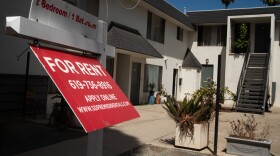Solar industry supporters say the California Public Utility Commission’s newly proposed rules for rooftop solar customers are a disaster.
The regulators are at the tail-end of a year-long review of the state’s Net Energy Metering rules. Those rules determine how utilities and rooftop solar owners interact. The review is mandated by the state legislature.
The proposed revisions call for major changes in the way California subsidizes rooftop solar energy, a proposal know as NEM 3.0.
The commission wants to add a flat grid connection fee, based on the size of a resident’s photovoltaic system, for customers who add solar. The typical San Diego Gas & Electric customer would pay a flat connection fee of about $65 a month.
The plan also calls for a sharp reduction in the value of rooftop-generated solar.
RELATED: California solar industry braces for change
Current rules tie electricity sell-back rates to the retail cost of electricity that the utilities sell to all customers, typically a few cents a kilowatt-hour lower. The CPUC proposal slashes the value of rooftop solar by about 80% setting sell-back rates at less than five cents a kilowatt-hour.
“We’re going to lose jobs,” said Bernadette Del Chiaro, of the California Solar and Storage Association. “We’re going to lose small businesses, and consumer, working and middle-class consumers are going to lose the ability to add solar panels to their home.”
Del Chiaro said the new rules 68,000 solar industry jobs at risk and will hurt the state’s ability to reach its net-zero carbon emission targets.
“SDG&E will reserve comment until our experts have an opportunity to review the 204-page proposed decision and evaluate its impact on our customers”SDG&E
“The state of California should avoid penalizing people that go solar,” said Del Chiaro.
Solar backers hope to lobby the governor and the CPUC commissioners with an eye on changing the proposal before the panel takes a final vote in late January.
“In order to curb climate change and provide reliable, affordable electricity, California needs more solar and storage, not less,” said Woody Hasting of the Climate Center. “Though the CPUC has outlined some meaningful benefits for qualified low-income customers, this proposal would put small-scale solar and storage out of reach for many lower to middle-income communities just as it was becoming more affordable.”
RELATED: California's solar marketplace could see some major changes soon
Part of the plan includes creating a $150 million a year fund to help low-income residents add solar. They would also be exempt from the steep grid connection fees.
SDG&E had nothing to say about the proposal. They did issue the following statement by email.
“SDG&E will reserve comment until our experts have an opportunity to review the 204-page proposed decision and evaluate its impact on our customers,” the statement read.
The utility-backed advocacy group “Affordable Clean Energy” for All hailed the proposed decision.
The group argues that rooftop solar customers are being subsidized by renters, seniors and disadvantaged communities.
“Currently, Californians who don’t have solar panels are paying about $245 more each year in electric bills to cover the costs for those who do have rooftop solar,” said Kathy Fairbanks, a spokeswoman for the coalition. “If NEM isn’t fixed, that $245 per year cost shift will grow to $555 per year by 2030.
The proposed CPUC rules also cut short the period of time that existing solar customers see the benefit of the rules when they first put panels on their roofs.
Instead of 20 years under the rules that existed when they signed up, NEM 1 and NEM 2 customers would be included in the NEM 3 system after 15 years.
RELATED: California Assembly Debating Solar Energy Reforms
“The proposal includes a raft of complex changes which, if approved, would put rooftop solar far out of reach for millions of Californians,” said Susannah Churchill, Vote Solar’s Western Senior Regional Director. “By drastically reducing monthly solar savings and adding new solar-only fees for the majority of residential solar users, the proposal will move us backward on clean energy and block many Californians’ ability to help make our grid more resilient to climate change.”
Critics argue the proposed rules will remove any financial incentive for residents to install solar panels and battery storage.
The regulators say the plan creates a financial incentive to install batteries because the plan keeps evening time-of-use electricity rates high.






